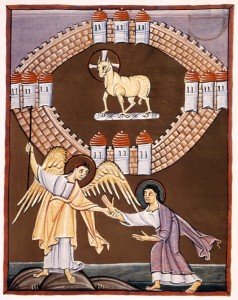In the last issue of this article I began giving a brief synopsis of the visions that are contained in Revelation. I presented the first two visions and would continue with the third.
- Seven angels blowing seven trumpets. A third of the earth burns up, a third of sea creatures and ships are destroyed, a third of earth’s rivers become poisonous, a third of the sun, moon, and stars are darkened. Giant locusts ascend from the smoke-filled “bottomless pit,” a great army of two hundred million cavalry invades, and a third of humankind is killed. (You can see that numerology plays a great role in these visions).
- The cosmic woman and the dragon. As a woman clothed with the sun, with the moon under her feet, and wearing a crown with twelve stars gives birth to a male child who will rule the world, a dragon waits to devour him. She and the child are rescued. War breaks out in heaven between Michael and the dragon, the “ancient serpent,” who is thrown down to earth where he makes war on the woman’s children.
- The final plagues and the seven bowls of God’s wrath.
- The destruction and fall of “Babylon the Great”.
- The defeat of the beast and his armies.
- The thousand years.
- The New Jerusalem.
There the visions end. The rest of chapter 22 contains concluding affirmations, warnings and promises. It ends: “The one who testifies to these things says, ’Surely I am coming soon.’ Amen. Come, Lord Jesus! The grace of the Lord Jesus be with all the saints. Amen.”
Recall that I shared with you that some Christians believe that the image-filled visions are to be interpreted as referring to events that are still in the future – that it speaks in veiled but decipherable language about the signs of the end and the second coming of Jesus. Christians throughout the centuries have often interpreted it this way. There was a flurry of end-of-the-world expectation around the year 1,000 as the first millennium ended. In the Reformation in the sixteenth century, Luther and others identified the great whore, Babylon the Great, the beast as Rome and the pope. He also thought the second coming was near.
Some Protestants from the nineteenth century on have proclaimed that the second coming is at hand. The expectation continues. One poll suggests that as many as 40 percent of American Protestants think it certainly or probably will happen in the next fifty years, a conviction based on the futurist interpretation of Revelation. Recall that Paul thought the Second Coming would happen in his time.

